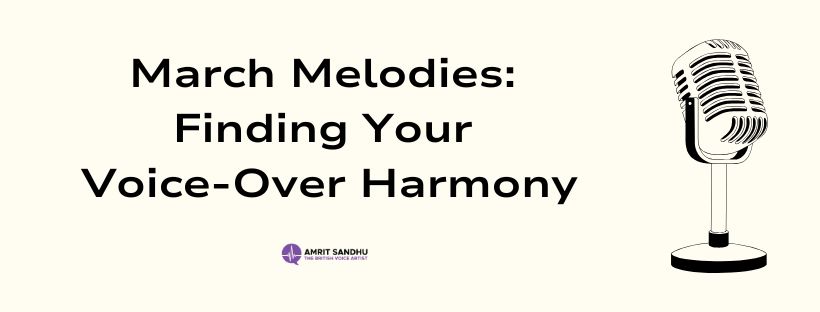March brings a fresh start, a chance to rediscover and refine. In the world of voice-over, this means tuning your voice to find its perfect harmony.
Imagine your voice as an instrument. It has its own unique timbre, range, and capabilities. But just like a violin needs a skilled player, your voice requires careful training and practice to reach its full potential.
- Warm-up: The Key to Vocal Agility
In the world of voice-over, where your voice is your instrument, proper preparation is paramount. Just as a musician wouldn’t jump onto a concert stage without warming up their instrument, a voice-over artist shouldn’t dive into a recording session without warming up their vocal cords.
Why Warm Up?
Your vocal cords are muscles, and like any muscle, they need to be warmed up before strenuous activity. A proper warm-up helps to:
- Increase Blood Flow: Warming up increases blood flow to the vocal cords, making them more flexible and responsive.
- Loosen Muscles: Vocal exercises help to loosen the muscles surrounding the larynx, allowing for greater vocal range and control.
- Improve Vocal Cord Vibration: Warming up helps to ensure smooth, efficient vibration of the vocal cords, leading to clearer and more resonant sound.
- Prevent Strain and Injury: A warmed-up voice is less susceptible to strain and injury, especially during longer recording sessions.
Simple Vocal Exercises for Voice-Over:
Here are some effective and easy-to-do vocal warm-up exercises:
Humming
- Start by humming a low, comfortable note.
- Gradually increase the pitch, moving up the scale.
- Repeat the process, moving down the scale.
- Humming helps to loosen the vocal cords and warm up the muscles in the throat.
Lip Thrill
- Lightly close your lips and blow air through them, creating a buzzing sound.
- Experiment with different pitches and rhythms.
- Lip trills help to massage the vocal cords and improve breath control.
Tongue Twisters:
- Practice tongue twisters to improve articulation and enunciation.
- Examples: “Peter Piper picked a peck of pickled peppers,” “She sells seashells by the seashore.”
- Tongue twisters help to loosen the tongue and improve clarity of speech.
Yawning:
- Mimic a yawn, opening your mouth wide and stretching your jaw.
- This helps to release tension in the jaw and throat muscles.
Breath Control Exercises:
- Practice deep, diaphragmatic breathing.
- Inhale slowly and deeply, expanding your belly.
- Exhale slowly and evenly.
- Strong breath control is essential for sustaining your voice and delivering a powerful sound.
How Long Should a Warm-Up Be?
A warm-up should take around 5-10 minutes, depending on the intensity of your recording session. Consistency is Key: Make warming up a regular part of your voice-over routine. Consistent practice will lead to improved vocal health, agility, and performance. Remember:
- Listen to your body. If you feel any pain or discomfort, stop the exercise and consult a vocal coach or doctor.
- Don’t force your voice. A warm-up should feel comfortable and relaxing.
- Hydrate. Drink plenty of water before, during, and after your warm-up.
By incorporating a consistent warm-up routine, you’ll be setting yourself up for success in the world of voice-over. Your voice will be stronger, more flexible, and ready to deliver captivating performances that resonate with your audience.
- Finding Your “Voice” of Voice-Over:
While your natural speaking voice is a starting point, the world of voice-over demands a unique “persona” – a distinct voice tailored to the specific demands of the medium. This “voice-over voice” often differs significantly from your everyday speech, requiring deliberate exploration and refinement.
The Difference:
- Clarity and Projection: Voice-over requires clear, concise articulation, designed to be easily understood through speakers and headphones. Everyday speech often relies on subtle nuances and inflections that might be lost in a recording.
- Tone and Delivery: Voice-over demands a specific tone and delivery style depending on the project. A commercial might require a friendly, upbeat tone while a documentary might call for a more serious, authoritative voice.
- Emotional Range: Voice-over artists must be able to convey a wide range of emotions, from excitement and enthusiasm to sadness and anger, often with minimal visual cues.
Discovering Your Voice-Over Persona:
- Experiment with Different Tones: Play with your voice, exploring different pitches, speeds, and inflections. Try a warm, friendly tone, a cool, professional tone, a playful tone, and a serious tone.
- Listen to Other Voice-Over Artists: Analyze the voices of successful voice-over artists in different genres. Pay attention to their tone, pacing, and overall delivery.
- Record Yourself: Record yourself reading different scripts or text passages, experimenting with various tones and styles. Listen back to your recordings critically, identifying strengths and areas for improvement.
- Seek Feedback: Ask friends, family, or fellow voice-over artists for feedback on your recordings. Their insights can help you refine your voice-over persona.
Embracing Your Uniqueness:
Don’t try to imitate others. Instead, focus on finding your unique voice-over style. Embrace your natural voice and develop it into a powerful tool for captivating audiences. Remember, a successful voice-over artist can seamlessly adapt their voice to fit a variety of projects and styles.
- Playing with Pace and Pitch:
A monotone voice can be dull and unengaging. To create captivating voice-overs, you need to master the art of varying your pace and pitch. Imagine your voice as a musical instrument, capable of expressing a wide range of emotions and nuances.
Slowing Down for Emphasis:
When you want to highlight a particular word or phrase, slow down your pace. This creates a sense of importance and draws the listener’s attention to the key information.
Speeding Up for Excitement:
To convey excitement or urgency, speed up your pace. A faster pace adds a sense of energy and momentum to your delivery.
Using Pitch Inflection:
Pitch inflection refers to the rise and fall of your voice. By varying your pitch, you can add emotion and interest to your recordings. A higher pitch can convey excitement or surprise, while a lower pitch can express seriousness or sadness.
Practice Makes Perfect:
Practice these techniques regularly, experimenting with different scripts and scenarios. Listen back to your recordings and identify areas where you can improve your pace and pitch variations. With practice, you’ll develop a natural ability to use these tools effectively, creating voice-overs that are both engaging and impactful.
- Articulation: Clarity is King
In the world of voice-over, where your voice is the primary means of communication, clarity is paramount. Listeners should be able to easily understand every word you speak, even through speakers or headphones. This is where articulation comes in – the art of speaking clearly and distinctly.
Enunciation and Pronunciation:
- Enunciation: Enunciation refers to how clearly you pronounce each syllable of a word. Avoid slurring your words or mumbling. Speak with confidence and precision.
- Pronunciation: Pronunciation is the correct way to say a word, including the sounds and stress patterns. Pay attention to common mispronunciations and practice saying words correctly.
Improving Your Articulation:
- Practice Tongue Twisters: Tongue twisters like “Peter Piper picked a peck of pickled peppers” can help improve your articulation and enunciation.
- Record Yourself: Record yourself speaking and listen back to identify any areas where your articulation needs improvement.
- Slow Down: Speaking slowly can help you focus on enunciating each syllable clearly.
- Use a Mirror: Use a mirror to observe your mouth and facial movements while speaking. This can help you identify any habits that might be hindering your articulation.
The Benefits of Clear Articulation:
- Easy Comprehension: Clear articulation ensures that your listeners can easily understand your message.
- Professionalism: Clear speech conveys professionalism and competence.
- Engagement: When your voice is clear and distinct, it is more engaging for listeners.
By mastering the art of articulation, you’ll be able to deliver voice-overs that are not only clear and understandable but also engaging and impactful.
- Breathing for Power:
Breath control is the unsung hero of voice-over. It’s the foundation upon which a powerful, resonant, and sustained voice is built. Just as a singer relies on breath support to hit high notes and sustain long phrases, a voice-over artist needs to master breath control to deliver clear, engaging recordings.
Diaphragmatic Breathing: The Key to Power:
Diaphragmatic breathing, often called “belly breathing,” is the most efficient way to breathe for voice-over. It involves using your diaphragm, a large muscle located beneath your lungs, to draw air into your lungs.
Benefits of Diaphragmatic Breathing:
- Sustained Voice: Diaphragmatic breathing provides a steady supply of air, allowing you to sustain your voice for longer periods without strain.
- Power and Resonance: Deep, diaphragmatic breaths create a powerful and resonant sound.
- Reduced Strain: Proper breathing technique reduces strain on your vocal cords, preventing fatigue and potential damage.
Practice Makes Perfect:
- Find Your Diaphragm: Place one hand on your chest and the other on your stomach. Inhale slowly and deeply, feeling your stomach expand. This is diaphragmatic breathing.
- Practice Regularly: Make diaphragmatic breathing a daily habit. Practice while sitting, standing, or even lying down.
- Incorporate Breathing Exercises: Include breath control exercises in your voice-over warm-up routine. Experiment with different breathing patterns and techniques.
Beyond the Basics:
- Listen to Your Body: Pay attention to your body’s signals. If you feel any tightness or discomfort, adjust your breathing technique.
- Hydrate: Stay hydrated by drinking plenty of water throughout the day. Hydration helps to keep your vocal cords healthy and lubricated.
By mastering breath control, you’ll unlock the full potential of your voice, delivering powerful and engaging voice-overs that captivate your audience.
- Recording is like a Performance:
Voice-over is more than simply reading words; it’s about bringing the script to life, captivating your audience, and creating an emotional connection. Think of yourself as an actor, using your voice to tell a story, convey emotions, and engage your listeners.
Bringing the Script to Life:
- Visualize the Story: Close your eyes and imagine the scene, the characters, and the emotions involved. This will help you bring authenticity and depth to your performance.
- Connect with the Text: Read the script with understanding and empathy. Focus on the meaning behind the words and the emotions they evoke.
- Vary Your Delivery: Don’t be afraid to experiment with your voice, adding pauses, inflections, and emphasis to highlight key points and emotions.
- Engage Your Audience: Imagine you’re talking directly to your listener, creating a personal connection through your voice.
Elevate Your Recordings:
- Practice, Practice, Practice: The more you practice, the more comfortable and confident you’ll become in delivering a captivating performance.
- Listen Back and Reflect: Listen to your recordings critically, identifying areas where you can improve your delivery and emotional impact.
By approaching recording as a performance, you’ll elevate your voice-overs from simple reads to engaging and memorable experiences for your listeners.
- Self-Reflection: Your Critical Listener
After a recording session, don’t just hit the “stop” button and move on. Self-reflection is an essential part of the voice-over process. Listen back to your recordings with a critical ear, focusing on areas where you can improve.
Listen for:
- Pacing: Is your pacing consistent and engaging? Are there moments where you rushed or slowed down too much?
- Articulation: Is your speech clear and easy to understand? Are there any words you slurred or mispronounced?
- Delivery: Do you sound natural and confident? Are you conveying the emotions and tone required for the script?
- Overall Impact: Does your voice draw the listener in and create the desired effect?
Be Honest and Objective:
It can be difficult to listen to your voice but try to be objective. Ignore your initial reactions and focus on identifying areas for improvement. Use Feedback to Grow:
- Take Notes: Jot down specific areas where you can improve.
- Practice: Work on the areas you identified during your next recording session.
- Seek Feedback: Ask a friend, family member, or fellow voice-over artist for their honest feedback.
By consistently reflecting on your recordings and using feedback to improve, you’ll become a more skilled and confident voice-over artist.
This March, dedicate time to refining your voice-over technique. By focusing on your voice, you’ll discover a new level of harmony and create recordings that truly resonate with your audience.



